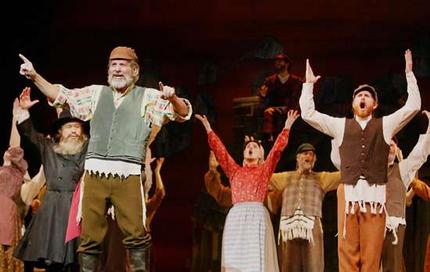Fiddler on the Roof Musical

picture from SMH
Just watch the “Fiddler on the Roof” 1971 movie version in DVD a few days ago. What spark my interest was that the stage musical is now back Melbourne for 5 weeks in June –July. The last time we watched it on the stage was in late 1990s or some 8-9 years ago by the same evergreen Mr. Topol !
The musical tells a story that has, what I reckon, a very universal poignancy, it's about trying to maintain strong cultural traditions and identity in the face of a continually changing world, partially fueled by the youth, that doesn't necessarily share the culture's values or self-assessment of worth. Other themes includes free will, faith in the midst of turmoil, anti-Semitism and having to “let go” when the children are coming of age….. I suppose only "baby boomers" or middle age people would appreciate it better or see themselves in Tevye’s shoes.
According to IMBd, “The plot is based on short stories written around the turn of the 20th Century by Sholom Aleichem, who was often called the "Russian Mark Twain". Aleichem wrote a number of works based on his character Tevye the Milkman, who has seven daughters (in the film, this was pared down to five). They live in the fictional Jewish shtetl ("village", or "little town or city") of Anatevka in Tsarist Russia in the early 1900s. The stories are "slice of life" stuff. A lot of attention is paid to Tevye's daughters and their potential suitors. One of the prominent conflicts with tradition is a struggle with arranged marriages versus marriages for love, but of course, being set in pre-revolutionary Russia, there are also political changes brewing, some of which have a profound affect on Tevye's family and village.”
Jewison , the film’s director, despite his name, was apparently not Jewish. He succesfully married a bit of campy humour and the Broadway theatrical to give us a fine piece of cinematic musical. Sequences like the opening "Tradition" montage are quite hilarious when set against a grand operatic attitude and the rhythmic coordination of cleaning fish, hanging slabs of meat, and so on. Yes, a lot of Fiddler is very realistic, but it's equally humorous and surrealistic most of the time.
Scene of country and village life always gives me some nostalgic feelings. One poignant scene is that of the part when Tevye was sending off his second daughter to the unknown Siberian frontier. After the smoking puff of the locomotive receding into the distance, Topol was left with a solitary figure in the vast wasteful landscape. I can identify with his sense of lost and loneliness.
Apparently, the “fiddler” as a cross between a metaphor for the Jewish spirit (and this is explained in more detail via a few lines of dialogue in the film) and an actual physical manifestation of a spirit. However we interpret the fiddler, the shots of him and his presence in the film are certainly poetic. Jewison also gives us some fabulous, surreal, wide landscape shots, such as those of agricultural fields and the beautiful "wasteland" in which the train tracks are set. There are a few scenes set on the banks of a river, overlooked by a bridge, that are reminiscent of particular Van Gogh paintings. And as a more subtle bit of surrealism, Jewison had cinematographer Oswald Morris shoot much of the film though a woman's stocking--the mesh is very clearly visible in some exterior shots.
Fiddler on the Roof takes an investment of time--it's three hours long, but it's well worth it. It offers great drama, great music, great humor and great tragedy in a beautiful package--you'll laugh, you'll cry, you'll sing, and you just might break a leg trying to dance.
I enjoyed it thoroughly, it helps me understand much more of the Jewish people in diaspora... and in a sense some similarity of the Chinsese in Daispora


